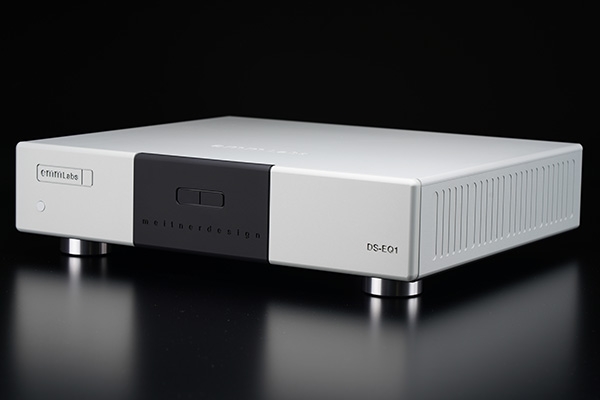| Columns Retired Columns & Blogs |
Why is it I never see any measurements done on phono stages to see RIAA curve tracking, noise, headroom etc etc etc
Cheers George

Meitner has been designing innovative hi-fi gear for the pro and consumer audio markets for more than 50 years, but for most of the last 30, he has been best known for his work with high-resolution digital audio and DSD recording (footnote 1). Despite this focus on digital—and despite that comment about the two leading phono cartridge technologies—deep in his heart, Ed still loves analog and has fond memories of the Kenwood optical cartridges from the 1970s, which I discussed in last month's Spin Doctor column. So when Ed read that a company in Japan called DS Audio was bringing back an improved version of the optical cartridge using modern materials, he contacted designer Tetsuaki Aoyagi to learn more.
As luck would have it—and as discussed in the April-issue Spin Doctor—DS Audio seeks partners willing to help push the optical-cartridge approach. The company is happy to share details about the technology with other manufacturers. Ed says that once he got his hands on a DS Audio W2 cartridge and learned what kind of circuit was needed to work with it, he whipped up a working model overnight and was astonished by the results. He thought it would be a game changer for vinyl playback. The experience rekindled his enthusiasm for vinyl records. He further developed and refined the circuit he had hastily assembled, creating what became the EMM Labs DS-EQ1 and Meitner Audio DS-EQ2 optical equalizers.
Meitner and EMM Labs (footnote 2) are the two sides of the same company, with Meitner focused mostly on lower cost price-competitive products while EMM Labs takes more of a cost-no-object approach. Ed said that the EMM Labs DS-EQ1 and Meitner DS-EQ2 use the same basic circuitry and are built in the same Calgary factory by the same people, but the EMM version has a more sophisticated power supply, balanced-output capability, and much more substantial aluminum casework. The output signal from an optical cartridge is naturally single-ended, so none of the optical equalizers have balanced inputs.

In Spin Doctor 11, I wrote about how the optical pickup system allows for a tremendous reduction in the moving mass of the stylus and cantilever, increasing the responsiveness of the cartridge's tracking. Ed explained some other advantages that I missed that first time around.
The way the optical cartridge generates a signal is fundamentally different from how a magnetic cartridge works. Whereas the output of a typical phono cartridge is determined by the velocity of the stylus as it is deflected, an optical cartridge measures the amplitude of the displacement. A defect on a record such as a scratch causes a sudden but usually low-amplitude deflection; it happens fast, but the displacement is small. An optical cartridge doesn't see it as a significant part of the signal. Consequently, an optical cartridge has less surface noise. Another reason an optical cartridge is quieter is that the output signal is larger; the signal/noise ratio is bigger.
What's more, Ed told me that the cartridge's output signal naturally incorporates part of the RIAA EQ curve, greatly simplifying the filtering requirements within the equalizer box.
In contrast to the DS Audio W3 equalizer I wrote about in the April Spin Doctor, the EMM Labs DS-EQ1 doesn't offer any bass-tailoring options, unless you count the selectable 15Hz rumble filter. When I tested the W3 cartridge with DS Audio's own equalizer, I didn't encounter any low-frequency resonance problems using my Brinkmann La Grange turntable and 12.1" tonearm, so I left the filter off while testing the DS-EQ1.
As with all optical-cartridge setups, there isn't really anything to adjust—no gain or loading options—just hook up your tonearm cables, a ground wire, and a pair of output cables, and you're ready to go.
At $12,500, the DS-EQ1 costs about 25% more than DS Audio's own W3. DS Audio lets you buy cartridges without their equalizer, so you can mix and match. A few different manufacturers now make optical cartridge equalizers, and any of them will work with any DS Audio cartridge.
Sitting side by side, the DS W3 has a somewhat deeper chassis, more heft, and a beautiful, curvaceous front panel. The EMM box is just as well made, more slab sided yet still very elegant.
To make things a bit easier during my comparisons, I turned both units around so that their rear panels were facing forward, which made it easier to switch out the cables. Before I got down to comparisons, I spent a few days simply playing records through the DS-EQ1 to get a handle on its overall character.
I started with the title track from The Lounge Lizards album The Voice of Chunk (veraBra Records vBr 25). The clarity and resolution of the EMM DS-EQ1 was immediately on show; with the EMM Labs equalizer in the system, I heard an uncanny sense of layering and depth. When electric guitarist Marc Ribot's blistering, angular solo started up, a new space opened up, floating in the soundstage. I clearly heard the size and characteristic sound of whatever space they recorded Marc's guitar cabinet in. John Lurie's alto sax was bright and clear but never hard or aggressive. The percussion bristled with detail and color.
Switching over to the DS Audio W3 equalizer, the sonic impression was still dominated by the speed, resolution, and low noise, but the tonal balance shifted slightly richer and darker, with a tad more punch behind Douglas Browne's drums, giving them a little more flesh on the bones as my friend Herb Reichert would say.

Changing gears, I played Vivaldi Lute Concertos and Trios (Hungaroton SLPX 11978) with lutist Dániel Benko. This is an exceptionally fine recording of a delightful performance, highlighting the tone character and sonic color of the lute and the string-orchestra accompaniment. As with the Lounge Lizards record, it was the EMM's ability to deliver sonic images with palpable depth and height that at first was the most striking, but when I focused on the sound of the lute, tonal details like the pluck of the natural gut strings and the resonance of the soundboard were real ear candy. Going back to the DS Audio equalizer, the sound took on a slightly richer and fuller-bodied quality, still with gobs of detail but with less of a spotlight on that part of the sonic picture.

I could make a convincing case for either the DS Audio W3 or the EMM Labs DS-EQ1 equalizer. Both sound stunning, allowing the qualities of the optical cartridge to shine through. The differences between EMM and DS Audio are more in their different flavors than in overall performance.
Here in New York, we have an amazing gelato shop called Il Laboratorio del Gelato, and if I'm headed there for a treat, I may think, should I get the Chocolate Amaretto Crunch or the Thai Chili Chocolate? Whichever choice I make, I know it's going to be heavenly.
Footnote 2: EMM Labs, 119-5065 13th St. S.E. Calgary, Alberta, Canada T2G 5M8. Tel: (403) 225-4161. Email: sales@emmlabs.com. Web: emmlabs.com.

Why is it I never see any measurements done on phono stages to see RIAA curve tracking, noise, headroom etc etc etc
Cheers George

... Toshiba optical cartridge?

Photocell attached to the end of cantilever with a led shone on it perhaps or the other way around, photocell or ultra mini led would be lighter than a moving Coil or Magnet
It still needs RIAA'ing, or does that mean they have flat output and need no RIAA'ing to be done, and that it's done within the cartridge body? there would be power sent to it for the led??
BTW I'm talking about other non optical phono stages also that don't seem to get measured as well as this.
Cheers George